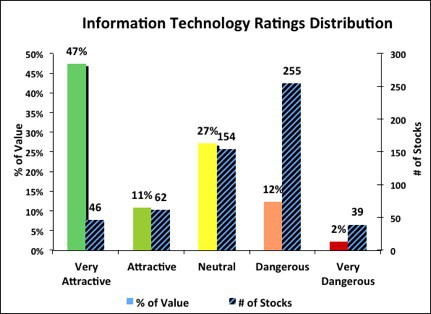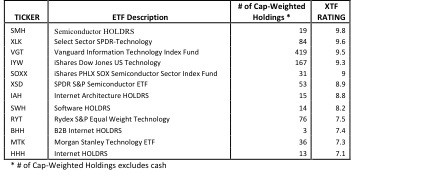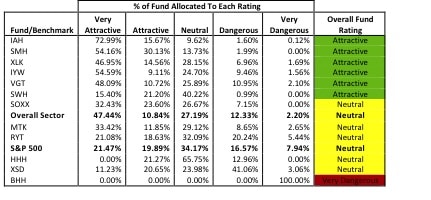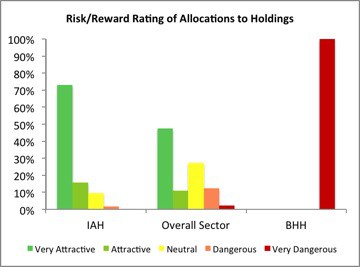After our first-quarter-2011 review of U.S. Equity Sector ETFs, We determine that the Consumer Staples, Consumer Discretionary and Health Care sectors are the best places to shop due to their Attractive Overall Risk/Reward ratings. Over the next several days, we will highlight our recommendations for the best and worst ETFs in every sector.
We start with the Information Technology sector, where our top picks for ETFs are: Internet Architecture HOLDRS (IAH) and Semiconductor HOLDRS (SMH). We also rate the investment merit of the top-12 tech sector ETFs.
Despite the Information Technology sector’s Neutral Overall Risk/Reward Rating, a few ETFs manage to earn an Attractive Overall Risk/Reward Rating due to their heavy weighting in attractive-or-better-rated stocks such as Apple (AAPL), Google (GOOG), Intel (INTC) and SanDisk (SNDK). Figure 2 shows how the Information Technology sector’s stocks and the market value attributed to them stack up under the microscope of our risk/reward rating system.
Figure 1: Information Technology Sector – Capital Allocation & Holdings by Risk/Reward Rating
 Sources: New Constructs, LLC and company filings
Sources: New Constructs, LLC and company filings
The Information Technology sector has only 14% of its value invested in dangerous-or-worse-rated stocks and 58% of its value invested in attractive-or-better-rated stocks. Although the Information Technology Sector only earns a Neutral Overall Risk/Reward Rating, its heavy weightings of attractive-or-better-rated stocks create large opportunity for attractive-or-better rated ETFs.
The key takeaway here is that the Information Technology sector offers both good and poor investment opportunities. The value of each ETF is derived from its constituents, so ETFs that overweight attractive-or-better-rated stocks, like IAH and SMH, are great investment opportunities while ETFs that overweight neutral-or-worse-rated stocks should be avoided.
When analyzing the Tech Sector ETFs, we started by identifying those ETFs with acceptable structural integrity as measured by XTF, an ETF research firm. We chose the 12 ETFs whose XTF rating was above the sector average XTF rating.
Figure 2: Info Tech ETFs With Acceptable Structural Integrity
 Sources: New Constructs, LLC; XTF and company filings
Sources: New Constructs, LLC; XTF and company filings
Figure 2 shows clearly that not all Technology ETFs are made the same. Different ETFs have meaningfully different numbers of holdings and, therefore, different allocations to holdings. Given the differences in holdings and allocations, these ETFs will likely perform quite differently.
After determining the structural integrity, we analyzed the investment merit of each ETF based on how it allocated value to each stock it held. Figure 4 shows how the 12 Information Technology sector ETFs stack up versus each other and the overall sector based on their Overall Risk/Reward Ratings and the allocation of their holdings by rating.
Figure 3: Investment Merit Based on Holdings and Allocations
 Sources: New Constructs, LLC; XTF and company filings
Sources: New Constructs, LLC; XTF and company filings
Attractive ETFs:
IAH, SMH, XLK, IYW, VGT, and SWH – these 6 ETF earn an Attractive Overall Risk/Reward rating and therefore, they are the only Information Technology ETFs we recommend. We specifically recommend IAH and SMH from this group.
Neutral ETFs:
5 ETFs allocate the value of their funds in a way that earns them a Neutral Overall Risk/Reward Rating. We recommend investors buy the very attractive and attractive stocks in this sector before buying any of the Information Technology ETFs except those we recommend.
Dangerous ETFs:
We recommend investors avoid BHH because it has only two holdings, both of which earn a Very Dangerous rating. Figure 5 highlights just how different BHH is compared to IAH and the overall sector. Given the small market value of the very dangerous-rated stocks in the Information Technology sector, one has to wonder how Merrill Lynch, the issuer of BHH, determined it should allocate all of its value to very dangerous-rated holdings.
Figure 4: Attractive and Dangerous Information Technology Sector ETFs
 Sources: New Constructs, LLC; XTF and company filings
Sources: New Constructs, LLC; XTF and company filings
Benchmark Comparisons
Sector Benchmark
IAH outperforms the overall Information Technology sector in quality of earnings ratings. IAH earns a Very Attractive Economic vs. Reported Earnings rating because its Economic Earnings are positive and rising while the sector’s Economic Earnings are positive and decreasing. Also, although both IAH and the sector earn a Very Attractive ROIC rating, IAH’s ROIC is 57% compared to the sector’s ROIC of 43.3%.
IAH also outperforms the sector in valuation ratings. IAH has a Price-to-EBV of 1.1, earning it a Very Attractive rating, and a GAP of 4 years compared to the overall sector’s Price-to-EBV of 1.9 and a GAP of 21 years.
Figure 5: IAH – Risk/Reward Rating
 Sources: New Constructs, LLC and company filings
Sources: New Constructs, LLC and company filings
Figure 6: Information Technology Sector – Risk/Reward Rating
 Sources: New Constructs, LLC and company filings
Sources: New Constructs, LLC and company filings
IAH more effectively allocates capital than the overall Information Technology sector. Per Figure 3 above, IAH allocates 88.66% of its value to attractive-or-better rated stocks while the sector only allocates 58.28%. IAH also only allocates 1.72 % of its value toward dangerous-or-worse rated stocks compared to the sector’s dangerous-or-worse weightings of 14.53%.
Market Benchmark
IAH outperforms the S&P 500 in quality of earnings ratings. IAH earns a Very Attractive Economic vs. Reported Earnings rating because its Economic Earnings are positive and rising while the S&P 500’s Economic Earnings are positive and decreasing. Also, although both IAH and the S&P 500 earn a Very Attractive ROIC rating, IAH’s ROIC of 57% dwarfs the S&P 500’s ROIC of 18.2%.
IAH also outperforms the S&P 500 in valuation ratings. IAH has a Price-to-EBV of 1.1, earning it a Very Attractive rating, and a GAP of 4 years compared to the S&P 500’s Price-to-EBV of 1.5 and a GAP of 26 years.
Figure 7: IAH – Risk/Reward Rating
 Sources: New Constructs, LLC and company filings
Sources: New Constructs, LLC and company filings
Figure 8: S&P 500 – Risk/Reward Rating
 Sources: New Constructs, LLC and company filings
Sources: New Constructs, LLC and company filings
IAH more effectively allocates capital than the S&P 500. Per Figure 3 above, IAH allocates 88.66% of its value to attractive-or-better rated stocks while the S&P 500 only allocates 41.33%. IAH also only allocates 1.72% of its value toward dangerous-or-worse rated stocks compared to S&P 500’s dangerous-or-worse weightings of 24.51%.
Methodology
The report offers benchmarks for (1) investors considering buying Information Technology sector ETFs and for (2) comparing individual ETFs to the Information Technology sector and the S&P 500. Our analysis is based on aggregating results from our models on each of the companies included in every ETF and the overall sector based on data as of 04/05/11. We aggregate results for the ETFs in the same way the ETFs are designed. Our goal is to empower investors to analyze ETFs in the same way they analyze individual stocks.
To make an informed ETF investment, investors must consider:
1) The structural integrity of the ETF and its ability to fulfill its stated objective. We use XTF, an ETF research firm, to find the top 12 ETFs with the best structural integrity rating.
2) The quality of the ETF’s holdings. We determine and ETF’s quality using our overall risk/reward rating system.
Given the success of our Rating system for individual stocks, we believe its application to groups of stocks (i.e. ETFs and funds) helps investors make more informed ETF and mutual fund buying decisions. Barron’s regularly features our unique ETF research. The first article is “The Danger Within”.

2 replies to "Good, Bad and Ugly Tech Sector ETFs"
[…] recommend investors short or sell FNSR and any ETFs that allocate to it. As detailed in in Good, Bad and Ugly Tech Sector ETFs, investors must beware the holdings of tech sector ETfs before buying them. Those ETFs have […]
[…] recommend investors short or sell FNSR and any ETFs that allocate to it. As detailed in in Good, Bad and Ugly Tech Sector ETFs, investors must beware the holdings of tech sector ETfs before buying them. Those ETFs have […]